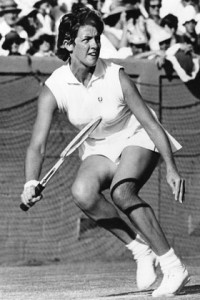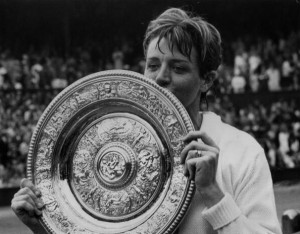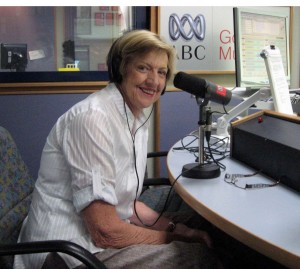Queens of the Court: Margaret Court, The Champion Among Champions

Margaret Smith Court stills holds the record for most Grand Slam singles titles (24) and most overall Grand Slam titles (62).
Let’s start at the top. There is, for Margaret Court more than any other player—man or woman—no other place to begin. For Court stands at the very top of tennis’ list of achievements.
Try this. She won a total of 62 Grand Slam titles: next in line is Martina Navratilova with 59, and both outstrip the next, Billie Jean King, at a mere 39. (The top man? Roy Emerson with 28.)
What about this? Twenty-four singles Slams: next in line is Steffi Graf at 22. (Roger Federer is way out of contention with his 15.)
Look at another. Court is the only person to win all 12 Slams at least twice. In fact, take out Wimbledon’s results (where she won only three singles and two women’s doubles), and she won the other 10 Slams at least four times.
And one more for good measure. Court is one of only three players to achieve a career “boxed set”—all three titles at all four Slams.
Not enough? Well, Court is one of only three women to win a calendar Slam (in 1970), and on four further occasions, she won three singles Slams in the same year.
Make no mistake, this woman dominates the record books now just as much as she dominated the opposition during her 17-year career.
While you absorb those statistics, consider this, too.
Between 1970 and 1975, the Australian Open did not hold a mixed doubles competition, and in 1965 and 1969, the mixed finals were abandoned due to bad weather (and Court was lined up to play in both). So it’s entirely possible that this remarkable woman could have won another half dozen Slams. Imagine it: 67 titles.
Court was a tall and powerful woman who nevertheless had to work hard to develop the physical attributes and co-ordination of her 5’9″ frame. She was quietly determined and single minded, willing to put in gym and road time to reach her targets.
Sure enough, by the age of 17, Court was a Grand Slam winner, taking the first of seven consecutive Australian singles titles. (She would go on to win four more!)
The Mother of All Champions
But the story of Court’s achievements is all the more extraordinary because of her personal time-line. For when Court—or rather Smith, as she was at the time—married in 1967, she retired for 18 months. She took another year out to have her first child, and then a further year to have her second.

Court kept playing despite the birth of two children and didn't retire until age 35.
It was not until she found she was expecting her third child, mid-way through a major tournament in Detroit in 1977, that she retired for good, aged 35.
So while Court was setting new benchmarks in athletic achievement, she also managed—a rarity in the mid 1960s—to combine her globetrotting success with motherhood.
With all these facts on the table, it would be easy to make assumptions about this statuesque woman from New South Wales. On paper, she epitomized
the newly-emerging “liberated woman,” much as her contemporary and great rival, Billie Jean King did. But she and King, for all that they had in common, could not have been more different.
But let’s start with what they did have in common: their tennis.
The King and the Queen

Margaret Court defeated Billie Jean King 14-12, 11-9 to win the 1970 Wimbledon title.
For a decade, these two women dominated tennis. Between 1966 and 1975, one or both of them played 35 of the 40 singles Slam tournaments, and together won 24 of them. They played each other in one of the greatest of Wimbledon finals, in 1970, both carrying injuries yet fighting through 46 games to a 14-12, 11-9 victory for Court.
Both were strong, fit and determined. They played attacking serve-and-volley tennis, but were not afraid to thump out the ground strokes too. This was the era of grass—only the French Open was different—and their fast, powerful tennis was hugely successful.
Physically, though, they were like chalk and cheese. Court towered over King by almost six inches. The Australian was serious, quiet, unhurried to the point of looking languorous, though with an unspoken, steely confidence. She had the easy elegance that tall, athletic women often have, and dressed in an unfussy skirt and polo as if to emphasize her Greek-statue stillness.
The Mother’s Day Massacre
A common feature in descriptions of Court is that she took the admiration of the men around her almost for granted. She had a very traditional view of family life and for the proper regard men and women should have for each other.
She had grown up with elder brothers, played tennis against men—indeed was coached for a time by the great Frank Sedgman—and enjoyed the camaraderie of highly successful Australian men as the tennis tour travelled the globe.
Court undoubtedly demanded and won respect from both the men and women around her. So it’s hard to know whether she made the biggest misjudgement in her career due to her confidence in the “natural order” of things, or her naïve belief that the respect she enjoyed was also enjoyed by other women.
Whatever the reason, the famous “Battle of the Sexes” became a defining moment in the fight for gender equality and also between those old adversaries, Court and King.
Bobby Riggs, a chauvinistic, 55-year-old former Slam champion, was on a mission. He wanted to undermine the campaign for women’s equality on the tennis tour and also turn it to his own financial advantage.
So he put out a challenge—backed by a $10,000 purse—to the top female players of the day: King, Court, and Chris Evert. He was actually after King, who he called “the sex leader of the revolutionary pack,” but she turned him down. Court, however, missed the political nuances of the invitation, and accepted what she thought would be an easy-to-win exhibition match.
When King discovered that Court had accepted the challenge, she tried to convey the importance of winning to her rival: “This is not about tennis…You have to win this match. You have no idea how important this is.”
King later said, “Margaret didn’t see the bigger picture.”
Court had maintained a dignified distance from the campaign for equal pay and equal treatment on the tour, and so was less awake to Riggs’s motives. She did, in any case, have unwavering faith in her ability to win the match. “I just thought, here is a man who has quite a big mouth.”
Unfortunately for Court, Riggs was bit more savvy than that. He had been training hard, had been taunting the “women’s libbers,” and most importantly of all, had been studying Court’s game. She played tennis like a man, so he would undermine her game by playing more like a woman.
And on Mother’s Day 1973, that is precisely what he did. After presenting her with a dozen roses “for the nicest mother in tennis,” he played short serves, drop shots, lobs and every other technique to undermine Court’s powerful rhythm. In under an hour, he had beaten her 6-2, 6-1.
The loss was enough to provoke King to accept a rematch. Court, having realized too late the wider implications of her defeat, gave King a few tactical tips. King went on to win a famous victory, and the campaign for equality was right back on the agenda.
Different Path, Old Values
But the personal path of Court diverged from King’s in a quite dramatic way from that brief moment of unity. Court had been raised a Catholic and, by the mid-70s, her faith was to take on an ever-growing importance in her life.
She converted to the Pentecostal church, trained at the Rhema Bible Training College during the 1980s, and went on to become ordained as a minister in 1991.
Shortly afterwards, she founded the Victory Life Centre in Perth, and has since presented her own television show on the Australian Christian Channel.

Court is still highly visible at the age of 67.
In embracing the teachings of her church, Court became a vociferous campaigner against gay rights. In 1990, she condemned Navratilova and other lesbian players for ruining the sport of tennis. She also fought the Western Australia Government on proposed new laws on gay rights. Meanwhile, of course, King has devoted much of her life to campaigning for both women’s and gays’ rights.
Yet in one of her most recent interviews, for the U.K.’s Sunday Times, Court describes King as the best player she ever faced. “We’re very different in stature, personality, and style, but had respect for one another’s games and knew we had to be at our best to win.”
Bearing in mind that Court’s reign took in wins over Evert on clay, and over Maria Bueno, Rosie Casals, and Evonne Goolagong on grass—all in Slam finals—and you realize what a compliment Court is paying her old rival.
Hearing her talk now, at 67, settled back in Perth with her family and her faith, Court’s astonishing achievements seem light years away: “I love the work I do now just like I loved the gift God gave me in tennis.”
So take a moment to look again at what this retired wife, mother, and pastor did way back when. Few, if any, will ever match it.
Court regards her U.S. Open win against Casals in 1970 as the best moment of her career. It won her both the calendar Slam and the U.S. triple crown. This 10-minute video includes, appropriately, the intelligent commentary of King.









